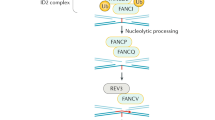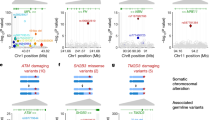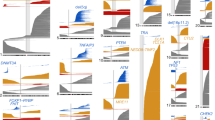Abstract
Fanconi anaemia (FA) is an autosomal recessive disorder associated with diverse developmental abnormalities, bone-marrow failure and predisposition to cancer1. FA cells show increased chromosome breakage and hypersensitivity to DMA cross-linking agents such as diepoxybutane and mitomycin C. Somatic-cell hybridisation analysis of FA cell lines has demonstrated the existence of at least five complementation groups (FA-A to FA-E)2,3, the most common of which is FA-A4. This genetic heterogeneity has been a major obstacle to the positional cloning of FA genes by classical linkage analysis. The FAC gene was cloned by functional complementation5, and localised to chromosome 9q22.3 (ref. 2), but this approach has thus far failed to yield the genes for the other complementation groups. We have established a panel of families classified as FA-A by complementation analysis, and used them to search for the FAA gene by linkage analysis. We excluded the previous assignment by linkage6 of an FA gene to chromosome 20q, and obtained conclusive evidence for linkage of FAA to microsatellite markers on chromosome 16q24.3. Strong evidence of allelic association with the disease was detected with the marker D16S303 in the Afrikaner population of South Africa, indicating the presence of a founder effect.
This is a preview of subscription content, access via your institution
Access options
Subscribe to this journal
Receive 12 print issues and online access
$209.00 per year
only $17.42 per issue
Buy this article
- Purchase on Springer Link
- Instant access to full article PDF
Prices may be subject to local taxes which are calculated during checkout
Similar content being viewed by others
References
Liu, J.M., Buchwald, M., Walsh, C.E. & Young, N.S. Fanconi anaemia and novel strategies for therapy. Blood 84, 3995–4007 (1994).
Strathdee, C.A., Duncan, A.M.V. & Buchwald, M. Evidence for at least 4 Fanconi anaemia genes including FACC on chromosome 9. Nature Genet. 1, 196–198 (1992).
Joenje, H. et al. Classification of Fanconi anaemia patients by complementation analysis: evidence for a fifth genetic subtype. Blood (in the press).
Joenje, H. for EUFAR. Assignment of Fanconi anaemia patients to complementation groups: an update. Acta Haematologica 93, 250 (1995).
Strathdee, C.A., Gavish, H., Shannon, W.R. & Buchwald, M. Cloning of cDNAs for Fanconi's anaemia by functional complementation. Nature 356, 763–767 (1992). Correction: 358; 434 (1992).
Mann, W.R. et al. Fanconi anaemia - evidence for linkage heterogeneity on chromosome 20q. Genomics 9, 329–337 (1991).
Dogget, N.A. & Callen, D.F. Report of the third international workshop on human chromosome 16 mapping 1994. Cytogenet. Cell Genet. 68, 166–177 (1995).
Gyapay, G. et al. The 1993–94 Généthon human genetic linkage map. Nature Genet. 7, 246–339 (1994).
Jorde, L.B. Linkage disequilibrium as a gene-mapping tool. Am. J. hum. Genet. 56, 11–14 (1995).
Rosendorff, J., Bernstein, R., Macdougall, L. & Jenkins, T. Fanconi anaemia: another disease of high prevalence in the Afrikaans population of South Africa. Am. J. med. Genet. 27, 793–797 (1987).
Duckworth-Rysiecki, G., Cornish, K., Clarke, C.A. & Buchwald, M. Identification of two complementation groups in Fanconi anaemia. Somatic Cell molec. Genet. 11, 35–41 (1985).
Savitsky, K. et al. A single ataxia telangiectasia gene with a product similar to PIS kinase. Science 268, 1749–1753 (1995).
Auerbach, A.D., Rogatko, A. & Schroeder-Kurth, T.M., International Fanconi anaemia Registry: Relation of clinical symptoms to diepoxybutane sensitivity. Blood 73, 391–396 (1989).
Litt, M. & Luty, A.L. A hypervariable microsatellite revealed by in vitro amplification of a dinucleotide repeat within the cardiac muscle actin gene. Am. J. hum. Genet. 44, 397–401 (1989).
Reed, P. et al. Chromosome-specific microsatellite sets for fluorescence-based, semi-automated genome mapping. Nature Genet. 7, 390–395 (1994).
Nikali, K. et al. Random search for shared chromosomal regions in four affected individuals: the assignment of a new hereditary ataxia locus. Am. J. hum. Genet. 56, 1088–1095 (1995).
Lathrop, G.M., Lalouel, J.M., Julier, C. & Ott, J. Strategies for multilocus linkage analysis in humans. Proc. natn. Acad. Sci. U.S.A. 81, 3443–3446 (1984).
Bengtsson, B.O. & Thomson, G. Measuring the strength of associations between HLA antigens and diseases. Tissue Antigens 18, 356–363 (1981).
Author information
Authors and Affiliations
Rights and permissions
About this article
Cite this article
Pronk, J., Gibson, R., Savoia, A. et al. Localisation of the Fanconi anaemia complementation group A gene to chromosome 16q24.3. Nat Genet 11, 338–340 (1995). https://doi.org/10.1038/ng1195-338
Received:
Accepted:
Issue Date:
DOI: https://doi.org/10.1038/ng1195-338
This article is cited by
-
Coregulation of FANCA and BRCA1 in human cells
SpringerPlus (2014)
-
A novel duplication polymorphism in the FANCApromoter and its association with breast and ovarian cancer
BMC Cancer (2005)
-
Fanconi anemia in Tunisia: high prevalence of group A and identification of new FANCA mutations
Journal of Human Genetics (2003)
-
The emerging genetic and molecular basis of Fanconi anaemia
Nature Reviews Genetics (2001)
-
Current Knowledge on the Pathophysiology of Fanconi Anemia: From Genes to Phenotypes
International Journal of Hematology (2001)



